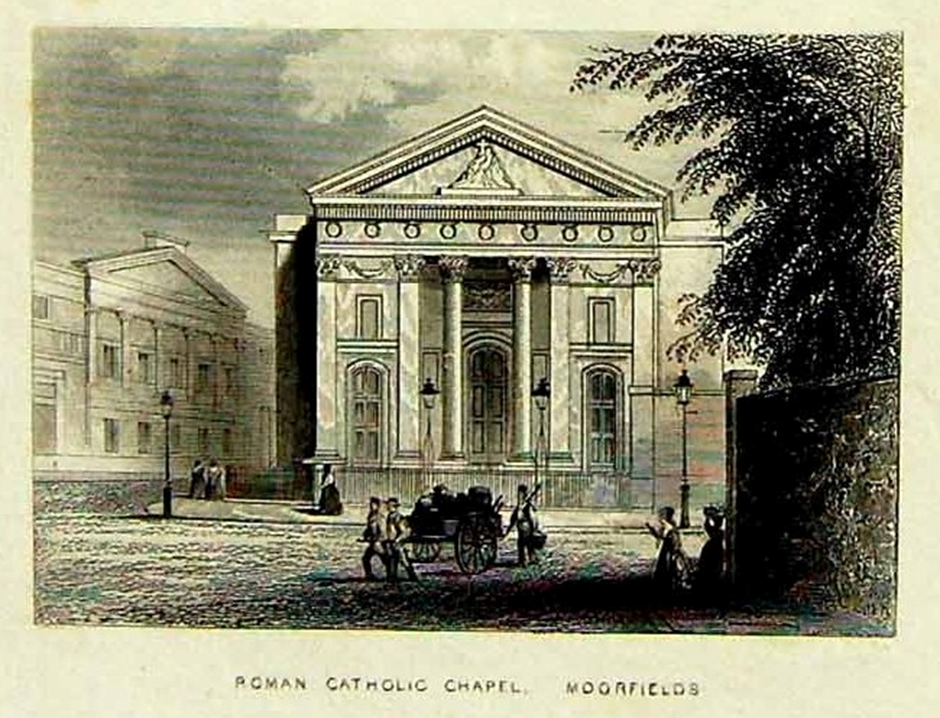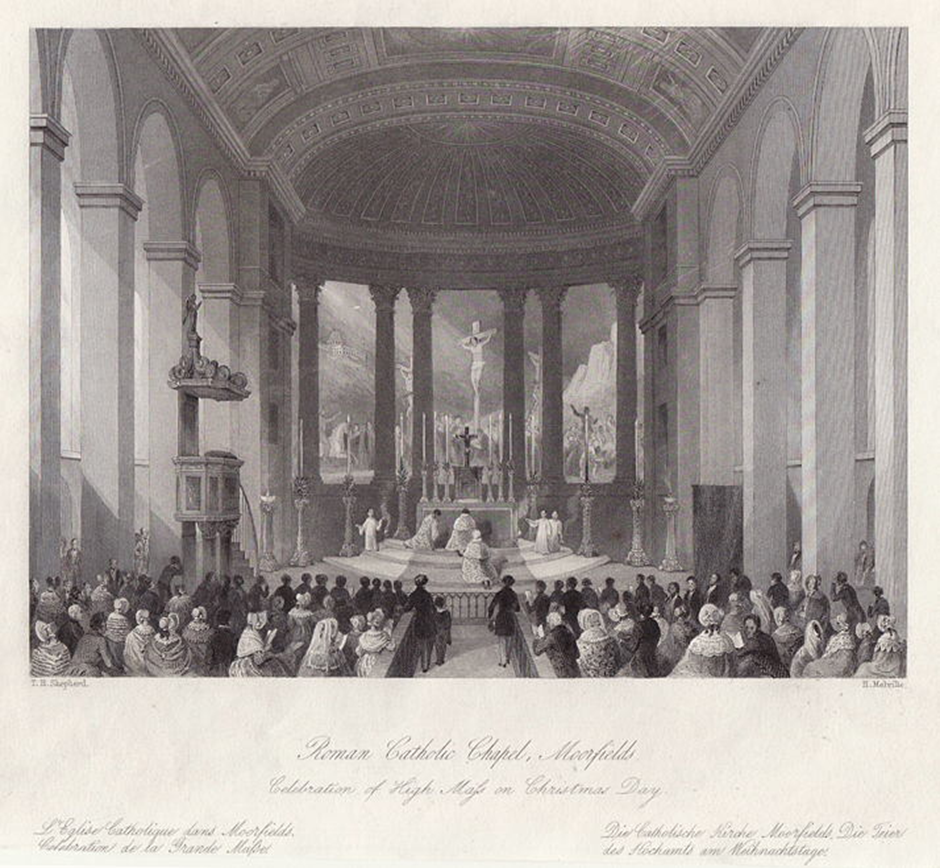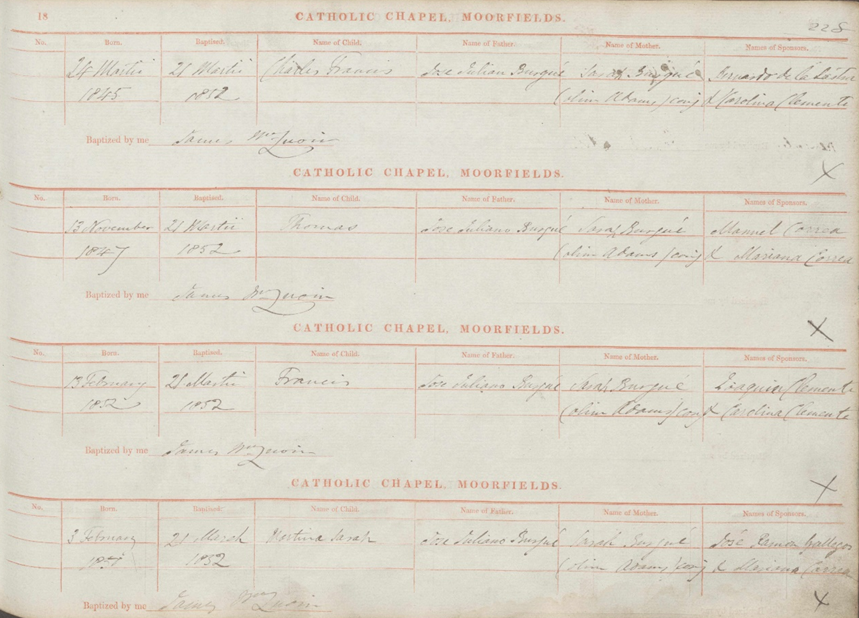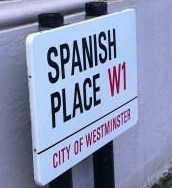One of the (many!) challenges of researching a migrant community, especially one as socially, ethnically and linguistically diverse as Hispanic London, is just how difficult it can be to figure out the ‘community’ element. Like, who knew who? Which families were in contact? Who did people rely on in a pinch? I wrote a couple of months ago about how Ancestry’s Freemasonry collection unexpectedly helped me to uncover a network of Spanish friends and colleagues. Today I want to share with you how a single page from Findmypast’s England Roman Catholic Baptisms collection (£) has revealed one family’s previously invisible social network.

Figure 1: St Mary Moorfields in the 1830s, engraving by Albert Henry Payne. Source: Wikipedia.
The Family
At least on the face of it, José Julián Burgué López (c.1818-1885) had little in common with the wider community of London Spaniards. He was not a merchant, sailor, shopkeeper, diplomat or hotelier, but a dock labourer. He did not come from one of the Iberian and colonial port cities where so many of London’s Spaniards had originated, but from Madrid. He did not live in the wealthy villas of Marylebone and Bloomsbury or the comfortable terraces of London’s commuterland, but in the dense and bustling tenements of the East End. And he had not brought a wife with him from Spain, but had married a local girl, Essex-born Sarah Adams.
José and Sarah married in January 1842 at St Dunstan’s Church, Stepney, where José gave his name as Joseph Burgue (no accent), his profession as labourer, and his father as Joseph Burgue, carpenter. The couple settled near to José’s workplace, which he charmingly recorded on the 1851 census as ‘St Kate Docks’. Their oldest son Joseph James, known as Frank, was born in August 1843 and baptised a few weeks later at Holy Family RC Church in Saffron Hill, Holborn.1 After this, however, José and Sarah seem not to have prioritised family baptisms until a cold March day almost nine years later.

Figure 2: St Mary Moorfields in 1836, engraving by S Melville. Source: Wikipedia.
The Baptism
On Sunday 21 March 1852, the Burgué family made their way from their home in the dockside parish of St George in the East to St Mary’s Roman Catholic Chapel in Finsbury Circus, just north of London’s ancient City wall. The chapel, which had opened in 1820, was now London’s pro- (or proxy) Catholic cathedral and an important focus for the city’s Roman Catholic activity.2 As the engraving above shows, the space into which José and Sarah brought their four children (aged between six weeks and seven years) was large and light, with strong neoclassical influences.3 The young parish priest who baptised the children, and whose signature you can see on the extract below, was 27-year-old Londoner Father James McQuoin.
The Godparents
Finding the baptism page with the four Burgué entries was a wonderful surprise. Unlike (most) Church of England registers, Roman Catholic baptism entries often record the names of the child’s godparents or sponsors. These family members or friends had to be practising Roman Catholics above the age of sixteen, and it was conventional, although not essential, for each child to have two: a godfather and a godmother. The entries for the four Burgué children name six different godparents, four godfathers and two godmothers, all of whom we assume accompanied the family to the chapel for the ceremony:

Figure 3: Extract from the baptism register of St Mary Moorfields. Source: www.findmypast.co.uk
- Charles Francis Burgué (b. 24 March 1845): Bernardo de la Lastra & Carolina Clemente
- Thomas Burgué (b. 13 November 1847): Manuel Correa & Mariana Correa
- Francis Burgué (b. 13 February 1852): Joaquín Clemente & Carolina Clemente
- Martina Sarah (b. 3 February 1850): José Ramón Gallegos & Mariana Correa
What was so surprising to me was that the family’s chosen godparents turned out not to be family members, but other members of the London Spanish community I had already met in completely different contexts. I had no other means of connecting them to the Burgué family (who had always seemed to me rather isolated from existing Spanish networks thanks to José’s work at the Docks and their residence in east London), but here they were, promising to look out for the spiritual welfare of the little Burgués.
The Clementes and Correas were both Anglo-Spanish families like the Burgués. Joaquín Clemente, who sometimes used the name William Clement, had married Gloucestershire-born Sarah Wilkinson at St James Piccadilly in 1833. Their seven children included Carolina, born in London in 1838, who accompanied her father to Moorfields to act as godmother to both Charles and Francis. Originally a confectioner, Joaquín was one of the first Spaniards to try his hand at professional hospitality in London, running pubs and later hotels in Westminster and Marylebone. At the time of the Burgué baptisms, he was in charge of a ‘Gran Hotel’ for Spanish visitors to London at 4-5 Harpur Street in Bloomsbury, but by 1858 he had left the hospitality trade to become an independent Spanish interpreter. Manuel Correa too was a professional interpreter; he and his Norfolk-born wife Marianne lived close to the Burgué family in St George in the East, so perhaps the two families had met locally. The couple had a young son, Manuel junior, who had been baptised at St Mary & St Michael Roman Catholic church in Stepney in November 1849. Correa died at St Bart’s Hospital in November 1856, aged just 37.
The two other godfathers are rather different, both from the Clementes and Correas and from each other. Bernardo de la Lastra has left little or no archival trail in the UK, although he may have been connected with the de la Lastra family of Santander and Mexico. A passenger list of 1850 records ‘B de la Lastra, merchant, of Mexico’ arriving at Southampton from Gibraltar,4 and another from October 1852 records ‘Bernardo de la Lastra’ of Spain arriving at Dover from Calais with a passport from the Mexican government.5 In contrast, José Ramón Gallegos’ short residence in London is much easier to explain. He was an idiosyncratic and self-taught musical instrument maker from Málaga who first came to London in 1851 to exhibit his ‘Guitar-harp’ at the Great Exhibition, staying at rented rooms in St Pancras. He made good friends in London and returned frequently, most notably for the Royal Society of Arts exhibition in 1862 when he entertained visitors (and journalists) with his agile and lifelike mechanical arm.6 How José met either of these men remains a mystery.
Afterwards
The family’s choice of godparents suggest that José was particularly well-connected for a dock labourer and indeed, within a few years his professional fortunes would change dramatically. Between 1853 and 1861, all four children baptised at Moorfields plus their three younger siblings were (re)baptised at local Anglican churches, baptism entries that might not record godparents’ names, but do record the father’s occupation. This tells us that at some point between November 1854 and January 1858, José left the docks to become a shipping agent and later a clerk, working for Manuel Pitarc at Billiter Street. Now he entered another familiar network, for on 25 May 1861, he was admitted to the Erith Freemasons lodge his boss had set up nearly four years earlier, along with two other new members: Málaga-born merchant ‘William Vilches’ (Guillermo Lorenzo Vilches Videgain) and Galician consul and publisher Ramón Silva Ferro.
The Burgué family’s story demonstrates how assumptions about people’s social circles based simply on work or residence or place of origin can’t ever provide the full picture. While I’ll probably never know how José Burgué met the Clementes, de la Lastra or the travelling craftsman Gallegos, I will certainly be more mindful in future of the unseen and unexpected connections that are the lifeblood of a community like Hispanic London.
Notes
- Subsequently London’s first Ukrainian church, now demolished. ↩︎
- St Mary Moorfields was Cardinal Wiseman’s pro-cathedral from 1850-1869. ↩︎
- This chapel was demolished in 1899 and a new church – the present one – opened a few yards away on Eldon Street. ↩︎
- A list of Aliens arriving aboard the Iberia from Gibraltar to Southampton. 13 Nov. 1850. England, Alien Arrivals, 1810-1811, 1826-1869. www.ancestry.co.uk : accessed 17 Oct. 2023. ↩︎
- Certificate of Arrival. No. 1352. Dover, 28 Oct. 1852. England, Alien Arrivals, 1810-1811, 1826-1869. www.ancestry.co.uk : accessed 17 Oct. 2023. ↩︎
- Widely reported, e.g. Weekly Chronicle, 25 Oct. 1862: 7. ↩︎
